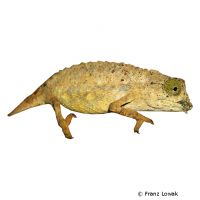Bearded Pygmy Chameleon (Rieppeleon brevicaudatus)
| Bearded Pygmy Chameleon Rieppeleon brevicaudatus | |
|---|---|
| Name | Bearded Pygmy Chameleon |
| Name Lat. | Rieppeleon brevicaudatus |
| Synonym | Rhampholeon brevicaudatus |
| Family | Chameleons |
| Family lat. | Chamaeleonidae |
| Order | Scaled Reptiles |
| Order lat. | Squamata |
| Origin | Tanzania, Kenya |
| Habitat | Rainforests |
| Diet | Insects |
| Humidity | 75-95 % |
| Behavior | ♂ territorial |
| Keeping | Individual, pair |
| Care Level | Experts only |
| Reproduction | Oviparous |
| Housing | Humid terrarium |
| Life Span | 3-5 years |
| Protection | CITES Appendix II; EU Annex B |
| Metric Units | |
| Size | 8 cm |
| Temperature | 22-25 °C |
| Temperature Local | 28-30 °C |
| Housing Size | 50 x 40 x 40 cm |
| US Units | |
| Size | 3" |
| Temperature | 72-77 °F |
| Temperature Local | 82-86 °F |
| Housing Size | 20" x 15" x 15" |
Distribution and habitat
The predominantly ground-dwelling Tanzania Dwarf Chameleons are widespread in eastern Tanzania and southeastern Kenya, from the lowlands to over 1,000 m elevation. They live in the rainforests and mountain forests, where they stay on the ground in the fallen leaves or on low bushes.
Maintenance
Minimum dimensions for the terrarium, according to the size and number of animals:
| One animal | 4KRL x 4KRL x 2,5KRL (L x W x H) |
Head-torso length (KRL) is measured on the largest animal. For pair keeping, increase the floor space by 20%. A terrarium of e.g. L 50 x W 40 x H 40 cm is recommended, which should be placed in a quiet and vibration-free place.
You need a well ventilated terrarium, structured with some branched climbing branches, plants as privacy screen, structured back and side walls (e.g. cork covering), a loose and moisture retaining substrate covered with foliage, e.g. forest soil-peat mixture, as well as a small water container or a dripper. The substrate should always be kept slightly moist (no waterlogging). Several times a day the inside of the terrarium should be finely sprayed with water (humidity), but a rain or mist system is better
| Temp. day: 22-25 °C | Temp. night: 18-20 °C | Temp. local: up to 30 °C | Humidity: 75-95 |
The lighting duration must be 10-14 hrs. depending on the season. They need a high light intensity. Special lamps with high UV-A and UV-B content are ideal.
Diet
The food supply consists of live insects, such as crickets, smaller grasshoppers, cockroaches and crickets. It is often possible to switch to commercially available ready-made food for insectivorous reptiles, which must be offered with tweezers. Wax moths should be fed infrequently and in very small amounts because of their large fat content. Regular addition of minerals and vitamins (dusting the food) is important. Since water is almost only absorbed in drop form from leaves or furnishings, a dropper is recommended, alternatively they can be watered daily from a pipette
A regular and varied diet promotes health and prevents deficiency symptoms.
Reproduction and breeding
The body shape in females resembles a leaf, males are narrower and more elongated in shape, possess a longer tail and a more distinctly serrated dorsal line.
The female buries her eggs (3-9 pieces) in the substrate, which must accordingly consist of a substrate suitable for burrowing. The incubation period is 40-50 days at a temperature of 23 °C. Small insects such as fruit flies and micro crickets are suitable as initial food for the young. The life expectancy can be 3-5 years.
Species protection
The animal population must be reported in writing to the competent authority immediately after the start of keeping. Your pet store will be happy to provide you with further information.
Protection of species: WA Appendix II; EU Appendix B. The proof of purchase is the required proof of origin for the animal. Please keep it safe!
Important
For communication and defense against enemies they vibrate high-frequency with their body. When threatened, they can play dead by dropping, darkening, closing their eyes and remaining that way for some time. For the resting phase, the lighting duration is shortened by 2-3 hours for about two months and the temperature is lowered by 3-4 °C.
The terrarium must have good ventilation without drafts and meet the species-specific needs. Measuring devices such as thermometers, hygrometers, etc. are necessary. The lighting has to correspond to the species-specific day-night rhythm and has to be placed in such a way that the animals cannot injure themselves. The terrarium should be locked in such a way that neither unauthorized persons can open it nor the animals can escape. Contamination must be removed regularly
Further literature can be found in your pet store.
References
Test: petdata; Image: Franz Lowak
Source: BMELV (1997): Mindestanforderungen an die Haltung von Reptilien; ENGELMANN (2006): Zootierhaltung - Tiere in menschlicher Obhut: Reptilien und Amphibien, Harri Deutsch Verlag
- Gemäß § 21. Abs. 5 Tierschutzgesetz idgF
